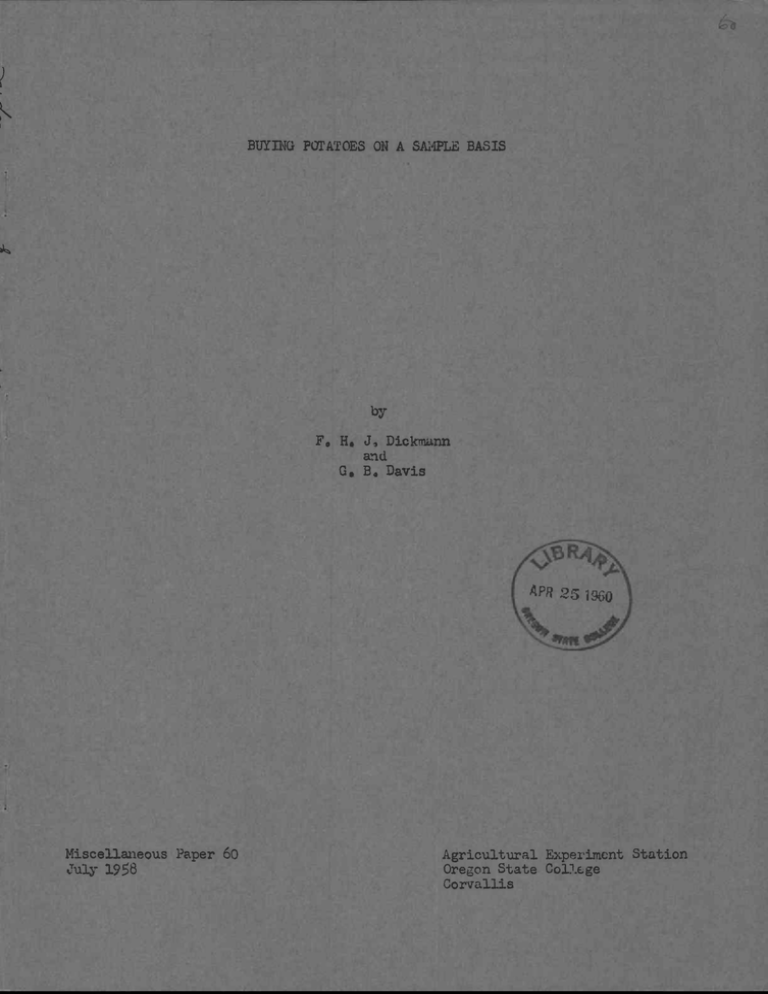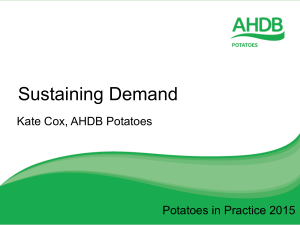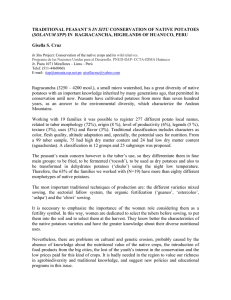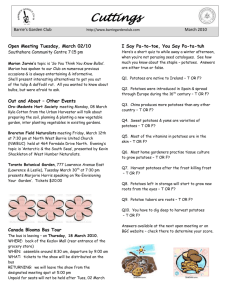BUYING POTATOES ON A SAMPLE BASIS by F. Ho J, Dickmann and
advertisement

6-6 BUYING POTATOES ON A SAMPLE BASIS by F. Ho J, Dickmann and 0, B. Davis Miscellaneous Paper 60 July 1958 Agricultural Experiment Station Oregon State College Corvallis TYING POTATOES ON A SAMPLE BASIS F. H. J. Dickmann and G. B. Davis • Oregon late-crop potatoes are sold to packers on either a packout basis or a sample basis. The packout method of sale is the most common. The sample method is relatively new to the table-stock industry in Oregon and has been used in only three packing houses in the late-producing areas. This method is standard buying practice for many potato-processing plants and sheds packing other vegetables, fruits, and nuts. Each method has advantages and disadvantages to growers and packers. One of the key points of controversy in the sample method relates to the confidence growers have in the ability of this method to predict the proportion of saleable potatoes in a truckload or a lot. Their question is: "How do you sample in order to get a representative picture of my potatoes?" This report is intended to answer that question. It shows the number of samples required to predict the contents of a load or a lot with different levels of accuracy. Advantages and Disadvantages of Sample and Packout awing In the packout method, a grower's potatoes are delivered to the packer's warehouse, going through dumping, grading, and packing operations. While a grower t s lot is being run, the packout is kept separate until the entire lot is packed. Then a final tally is made by the packer, and the grower is paid on the basis of the count. At that time, ownership passes from the grower to the shipper. In sample buying, the grower t s potatoes are delivered to the packing house and weighed before unloading. While potatoes are being unloaded, a sample is 'Research Assistant and Associate Agricultural Economist, respectively. drawn and inspected to determine grade composition. Percentages of the different grades found in the sample are applied to the entire load. The grower is paid for his potatoes on that basis. Ownership passes to the packer at the time grade composition of the sample is determined. Comparing the two buying methods from the packer's standpoint, sample buying has certain advantages. It permits continuous operation of the packing line, with no interruption of flow at the end of one lot and at the start of a new lot. Time and labor required for periodic packout counts are eliminated. Potatoes maybe received from two or more growers at the same time, insuring a constant rate of flow over the sorting table. When packing in advance of orders, floor space can be better utilized if it is not necessary to keep lots separate. Any benefits derived from the tolerance permitted under U. S. grade standards would accrue to the packer. These benefits would be received by the grower in packout buying. Grower relations and confidence might be improved through sample buying. When two or three grades of potatoes are packed in three or four sizes of containers, the grower sometimes questions accuracy of inventories. In sample buying, this possible friction point does not exist because title to the potatoes has passed to the packer before they are graded and packed. Another friction point eliminated is the grower's estimate of the number of his U. S. No. 1 potatoes that appear either in the U. S. No. 2's packed or in the cull chute. This may occur as a result of sorting errors or potatoes being lowered in grade as a consequence of bruising in the packing process. This can be a problem to the packer. He may grade closer than in packout buying, since he owns the potatoes prior to packing and any losses of marketable potatoes in the packing process area cost to him. The condition of the potatoes in some lots may be such that either more sorters or slower damping would be necessary to insure packing of all marketable potatoes. This point is discussed later. "3. The major advantage to the grower is he is paid for the amount and quality of potatoes he sells, as indicated in the sample. He suffers no direct loss as would happen if good potatoes are lowered in grade in the packing process. A limited number of comparisons were made of the grade content of the field-run potatoes and the packout of the same lots. They indicated some loss of U. S. No. 1 potatoes in the packing process. If, for example, the lot actually contained 50% U. S. No. l's but only 45% were packed, this could be an appreciable loss in income to the grower. With a yield of 300 hundredweight of field-run potatoes per acre and U, S. No. 1 price of 42 per hundredweight, the loss would amount to 430 per acre. AscuraszaSElui . am• The sampling problem from the packer's standpoint is one of insuring that each grower's lot of potatoes is measured to the satisfaction of the grower. This objective requires a different sampling procedure than if the packer is concerned only with making sure that his season's purchases are no greater than his sales. If the latter were his primary doncern, an extremely small sample would be needed. The sample for each grower's lot might be above or below the actual content of the lot, but over the course of the packing season and the many separate lots received, these deviations would balance out, Obviously, this is not the goal of the packer. He must be willing to sample heavily enough to make an equitable settlement with each grower for each lot. The number of samples per load depends largely on tun considerations: (1) number of loads in a particular lot, and (2) degree of accuracy desired,V Table 1 shows the sampling 2/This assumes that the variations in the potatoes being sampled will fall within the range in variation found in the lots on which the sampling procedure is based. U. S. No. 1 content in test lots varied from 32% to 7L% of the field-run potatoes. This range should include virtually all potatoes packed. plan required to satisfy these conditions. For example, suppose a grower estimates that his lot will consist of 25 loads, and that a 2% level of accuracy is satisfactory to both grower and packer. The level of accuracy would indicate that if the actual percentage of U. S. No, l's in the lot is 50%, the sample would show an average percentage plus or minus 2%, or from 148% to 52%. In this example, three 20-pound samples would need to be taken from each load to achieve this level of accuracy. For the same size lot of 25 loads, 11 samples would be needed for a 1% level of accuracy, 2 for a 3%, and 1 for a 14% level. It is doubtful if the heavy sampling would be satisfactory to the packer because of the cost of sampling. The grower probably would not be satisfied with a sample of one per load because of accuracy. The sampling plan shown in Table 1 was designed for U. S. No. 1 potatoes, U. S. No. 2 potatoes would seldom be sampled since they usually account for only a small proportion of marketable potatoes, and the price received for No. 2's is low compared to that of No. its.' Some question may be raised relative to the use of the U. S. No. 1 sampling plan for reliably predicting the proportion of U. S. No. 2 potatoes in a grower's lot. This plan will give a satisfactory degree of accuracy. This is illustrated in Table 2. If the number of samples drawn is for the 3% limit of accuracy of U. S. No, 1 1 s and the lot actually contains 10% U. S. No. 2's, the sample will show that the No. 2's will fall between 8% and 12% (10 2 2). Drawing samples for a 2% limit of U. S. No. 1 1 s from a lot actually containing 20% U. S. No. 2's, the sample would show the U. S. No. 2 content to be from 18.2% to 21.8% (20 ! 1.8). This is true regardless of size of the lot. Some Costs of Buying Each method of buying has costs not common to the other. In buying on a packout basis, costs stem from idle crew time when changing from one lot to TABLE 1. NUMBER OF 20 -POUND SAMPLES PER TRUCK NEEDED TO MEASURE U. S. NO. 1 CONTENT OF DIFFERENT SIZED LOTS OF POTATOES Accuracy Desired Number of Truck Loa4s Percenta e of Actual U. S. No. l Content) in lot3/ .1 3% 2% 4% (Samples per Truckload) 5 5 )4 114 6 10 27 7 3 2 25 11 3 2 1 5o 6 2 1 1 100 3 1 1 1 150 2 1 1 1 'The sample will be within the limits specified in 19 out of 20 cases. 2/Net weight of potatoes assumed to be 6 to 8 tons per load. TABLE 2. ACCURACY OF U, S. NO. 1 SAMPLING PROCEDURE WHEN APPLIED TO U. S. NO. 2 CONTENT Level of Accuracy Used Percent U. S. No. 2 in Lot Sam•lin for U. S. No. 1 1% 2% (Percent Limit of Error 3% of 14% U. S. No. 2 - plus or minus) 1 5 04 .8 1.2 1.6 10 .7 1.3 2.0 2,8 20 09 1.8 2,8 3.5 30 1.0 2.0 3.0 3.9 1i1,•••n•n•••n•.1.1.1•1.411.1•1ms. 1/The sample will be within the limits specified in 19 out of 20 cases. -6.. another. As the last of the potatoes from one lot pass over the sorting belt, rate of flow drops sharply until all potatoes in the lot are packed, As the tally for the packout is being taken, the new lot starts over the belt at a low rate of flow and gradually increases. During the changeover, labor costs of course continue--but potatoes are only being packed slowly, if at all. The time lost by the breaks for lots varies among packing houses, and the frequency of such breaks also varies. The estimates of packing-house operators are summarized below, Ten-Minute Breaks per Week Estimated Cost per Week 21 4 $18 6 27 8 36 10 45 12 54 1/Based on 20 workers at average hourly wage of 1.35 for a 40-hour week. Break-for-lot costs are eliminated in sample buying, but additional costs would be incurred. The sample must be drawn and grade determinations made. The cost of this work utuld depend on the number of samples drawn, number of loads sampled per day, and costs of the inspector. The present Inspection Service charge is 0.60 per hour. This rate would apply only to the time of drawing the sample and determining grade composition. It might be possible for a packer employee to draw the sample from each load and set it aside so that the inspector could examine several samples at one time. The services of a packer-hired inspector would cost less per hour. Also, if his sampling work did not take his full time, he could be used in other capacities. .7. In sample buying, if any appreciable quantity of the U. S. No. 1 potatoes were being inadvertently packed as No. 2's or were going into the cull chute, the packer might be forced to add additional sorters or reduce the dumping rate in order to prevent this from occurring * If more sorters were added, the packer would have a larger saleable output per day * His added net revenue from the sale of these potatoes would apply against the additional sorting costs. The above shows that a change from packout to sample buying probably would increase the packer's costs only slightly. Benefits cited earlier may more than compensate for any added costs. Sampling Procedure Drawing the sample,: Since the weight of potatoes in each sample will be but a fractional percentage of the total load, a slight error in the sample becomes a large error when applied to a truckload. To keep the possible error at a minimum, samples should be drawn as the potatoes leave the bulk truck, and care should be taken that the con- tainer for collecting the sample catches all potatoes rather than skimming from the top of those moving into the hopper of the elevator. When more than one sample is to be drawn per truck, samples should not all be collected at the same time. For example, if three samples are to be taken, one should be drawn during the first one-third of unloading time, one during the second, and one in the final one-third. Shrinkage: Foreign matter in a truckload of field-run potatoes may range from practically noneto as much as 5% of total weight of the load. It may be in the form of rocks or clods, vines or other vegetative material, loose soil, or soil adhering to individual tubers. The amount of any of these present depends upon the nature of the soil in the field, method of harvesting, soil moisture at harvest time, size and shape of the potatoes, and methods of handling harvested potatoes to and from storage. It is not practicable to measure this foreign matter when inspecting samples, and a percentage allowance can be negotiated either for the season or for each lot. The allowance should be subtracted from net weight of the load, and the grade composition of the sample applied to the remainder. Inspection: Potatoes should be washed before inspection. Removing adhering soil makes for a more accurate statement of weight relationship between different sizes and grades, and may expose minor defects not visible on a dirty tuber. A scale that indicates one-ounce increments is desirable. Gradations of 1/4 pound or greater make possible an appreciable rounding error. Procedures in Making_the StudZ This study is based on a statistical analysis of the variation in grade composition of over 30 different lots of potatoes handled in Oregon's late-crop. producing areas. Eight samples of approximately 20 pounds each were drawn from 37 truckloads. Grade composition of each sample was determined by a Federal- State inspector. Potatoes contained from 32% to 74% U. S. No. l's. Statistical analysis of the variation within loads and between loads in the same lot were used to show the number of samples required for different limits of accuracy.



